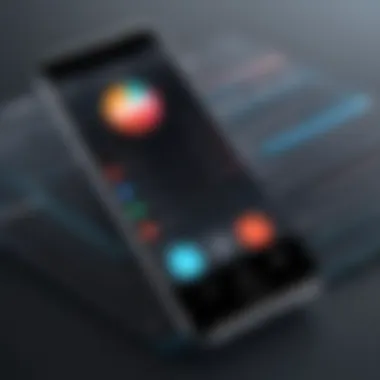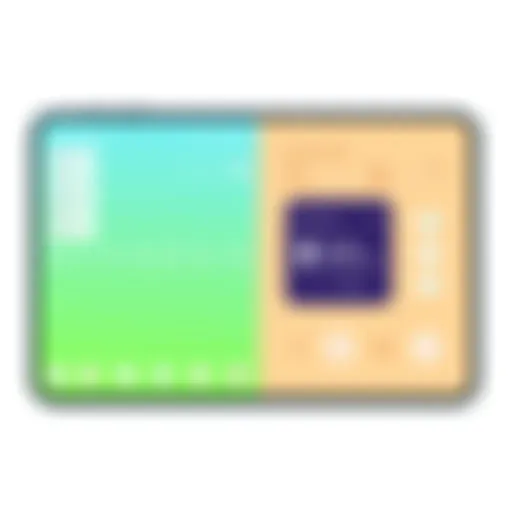How to Record Phone Calls: A Comprehensive Guide


Intro
Recording phone calls has become increasingly important in today's fast-paced world. The ability to capture conversations can serve various purposes such as providing clarity in personal matters, documenting important business discussions, or retaining information for quality assurance.
In this guide, we will discuss the methods available for effectively recording phone calls. We will delve into the legal considerations one needs to be aware of, examine the necessary software and hardware, and offer insights into platform-specific solutions.
Furthermore, individuals should understand the specific built-in features available on smartphones, the top third-party applications, and even systems for desktop computers. Ultimately, this article aims to ensure that readers not only learn how to record calls but also do so compliant with applicable laws and regulations.
Key Features
When considering how to record phone calls, there are several key features and factors to consider. Phone call recording is more than just pressing a button; it involves understanding the technology, hardware, and potential legal implications. Each aspect plays a critical role in achieving successful call recordings.
- Quality of Recording: The clarity is essential. A high-quality recording will retain every nuance of the conversation.
- Ease of Use: The recording method should be straightforward, allowing the user to focus on the conversation rather than technicalities.
- Integration with Other Tools: Some applications and systems allow integration with CRM or other software, enhancing the utility of recorded calls.
The design and build quality of devices can also impact the recording process. For instance, smartphones with superior microphones can yield clearer audio, while older models may present challenges. Keeping these considerations in mind will aid in selecting the best recording method.
Legal Considerations
Before recording any phone call, it's imperative to understand the legal landscape surrounding the action. Laws vary across regions and individuals must ensure compliance before proceeding.
Here are some essential aspects to keep in mind:
- Consent: Many jurisdictions require at least one party's consent to record a call. It is important to know whether your area follows one-party or two-party consent laws.
- Privacy: Violating privacy laws can result in severe consequences. Always inform the parties involved that the call is being recorded.
"Recording conversations without consent can lead not just to ethical concerns but also legal repercussions."
Software Options
There are multiple software solutions available for recording phone calls. Different devices and operating system requirements also lead to unique solutions, making it vital to choose wisely.
Some notable options include:
- Built-in Features: Many modern smartphones, like the iPhone and Samsung Galaxy series, come with native call recording features. Understanding how to access these features is essential.
- Third-Party Applications: Applications like ACR Call Recorder, Rev Call Recorder, and TapeACall offer versatile and feature-rich solutions for recording calls across platforms.
By exploring these various options, individuals can find a method that aligns with their needs while remaining compliant with relevant regulations.
Understanding Phone Call Recording
Recording phone calls is a practice that has gained significant traction in various sectors. Understanding this subject is essential as it provides clarity on the technology involved and the reasons behind the need for recordings. Many individuals and businesses find value in capturing conversations for various purposes, thereby influencing productivity and decision-making.
The Purpose of Recording Calls
Recording calls serves multiple purposes. Primarily, it is about preserving information. Conversations often contain valuable insights that can be easily forgotten. By capturing these discussions, users can refer back to them, ensuring accuracy and better responses in future interactions. Additionally, recording can help in monitoring compliance in business settings, where calls must adhere to specific regulations. Thus, the purpose extends beyond mere memory retention; it encompasses clarity and accountability.
Common Uses for Recorded Calls
Documentation
Documentation is one of the most prominent uses of recorded calls. By having a permanent record, users can ensure all information discussed is accurately captured. This provides clarity among team members, especially in scenarios involving complex discussions over strategies or project details. The ability to revisit conversations fosters transparency and can help to resolve any disputes that may arise later.
The key characteristic of documentation through call recordings is its reliability. Unlike notes that can be misinterpreted or forgotten, a recorded call is an exact representation of what was said. This reliability makes it a popular choice among professionals who need concrete evidence in their work. However, one disadvantage lies in the storage of these recordings, as they may consume significant digital space over time.
Training and Quality Assurance
Training and quality assurance benefit immensely from recorded calls. Companies increasingly utilize recordings to improve employee performance. Listening to actual interactions aids in identifying strengths and weaknesses, providing a practical learning experience for staff. It also enables supervisors to offer constructive feedback based on real examples, which can be more effective than theoretical training alone.
A unique feature of using recorded calls for training is the authenticity it presents. Employees can hear their own speech patterns, choices of phrases, and overall communication style. Consequently, they are often more receptive to feedback based on real examples. The downside could be that recordings may reveal less flattering moments, potentially causing concerns about privacy and morale.
Legal Evidence
Legal evidence is another critical aspect of call recording. In many cases, recorded conversations can serve as crucial evidence in legal disputes. These recordings can clarify contracts, agreements, or client intentions, significantly impacting court proceedings. Call recording thus becomes a necessary tool for legal professionals.
The primary characteristic of legal recordings is their potential weight in court. If properly documented and stored, these recordings can reinforce claims made by legal representatives. However, the challenge lies in ensuring that these recordings comply with local laws. Mismanagement or lack of consent might render them unusable in a legal context, making it imperative for all parties involved to understand the ramifications of recording calls under legal scrutiny.


Legal Considerations
Recording phone calls is not simply a technical exercise. It raises various legal issues that need careful attention. Understanding these legal considerations is crucial for compliance and ethical practices. Ignoring them can result in serious consequences, including legal penalties. Hence, having awareness of local laws and best practices will help you navigate the complexities associated with phone call recording.
Understanding Local Laws
Legal norms governing call recording vary significantly across different jurisdictions. It is essential to grasp these nuances to avoid unintentional violations. Knowing what is allowed in your area can empower users to utilize phone call recording tools without fear of legal repercussions.
Consent Requirements
Consent requirements dictate how you must gain permission before recording a conversation. Many jurisdictions need all participants in a conversation to agree to the recording. This approach promotes transparency and respects individuals' privacy. It builds a foundation for mutual trust and understanding in communication. On the other hand, obtaining consent can be burdensome in spontaneous conversations, which diminishes its practicality. Therefore, while it may provide beneficial insights into ethical recording practices, the need for consent can present challenges during execution.
One-party vs. Two-party Consent
The distinction between one-party and two-party consent is critical in the context of legality. In one-party consent jurisdictions, only one participant needs to be aware of the recording. This can be beneficial in situations where obtaining consent from every party is impractical. However, two-party consent means that all involved must agree to the recording. This requirement can complicate interactions, particularly in multi-party conversations. Each method has its unique implications that can shift the landscape of recording effectiveness and legality in user practices.
Best Practices for Compliance
Compliance with legal standards related to call recording is not only about avoiding penalties; it demonstrates respect for privacy and legality. By following best practices, users can minimize risks while maximizing the benefits of recorded calls.
Informing Call Participants
Informing call participants about the recording is a fundamental practice. It is not merely a legal requirement in many places but also an ethical obligation. Keeping participants informed nurtures transparency. This practice also can serve as a deterrent against potential misuse of recorded content. Benefiting from this approach, users can create a more comfortable environment for candid discussions. However, openly sharing that a call is being recorded might inhibit some conversations. Thus, this practice may have mixed effects depending on context.
Documenting Consent
Documenting the consent of all participants is a significant step for legal compliance. This process entails keeping records of any agreements made regarding call recording. The documentation can serve as a safeguard in case any disputes arise later. This practice not only reinforces legal compliance but also establishes accountability among participants. However, maintaining proper documentation can be cumbersome. Thus, it could require additional administrative work that some may not find appealing.
In summary, understanding the legal considerations of phone call recording is essential. By being aware of local laws, consent requirements, and best practices, users can adhere to legal standards while leveraging the benefits of recording their calls.
Methods for Recording Calls
Understanding the various methods for recording phone calls is essential. Each method has unique advantages and technical requirements. Utilizing built-in features, third-party applications, or desktop computer solutions can noticeably enhance the ease of capturing important conversations.
Built-in Features on Smartphones
Android Devices
Most Android devices come with a built-in call recording feature. This native functionality simplifies recording and offers a straightforward solution. Its key characteristic is the integration within the operating system itself. This allows users to activate the feature without needing additional apps. The unique feature of Android's call recording is that it provides a seamless experience. Users can start or stop recording with a simple tap.
However, disadvantages can include compatibility issues with some carriers or devices. Not all Android models support this feature, leading to inconsistent user experiences. Therefore, it is crucial to verify if your device supports call recording.
iOS Devices
Unlike Android, iOS does not support recording calls natively. Users must rely on external solutions. The key characteristic of iOS is its strict privacy policies, which prevent the recording capability from being included. The unique feature here is the use of third-party apps or services routed through a secondary device. With tools like Google Voice, users can record calls, but certain limitations exist.
The disadvantage of this approach is that it can be less straightforward. Users have to navigate multiple steps, which can complicate the process. Understanding these limitations is important for iOS users who need to record calls effectively.
Using Third-Party Applications
Popular Call Recording Apps
Several third-party applications excel in recording phone calls. Apps like Rev Call Recorder and ACR Call Recorder present robust options. The key characteristic of these apps is their breadth of features. Most provide easy access to recorded files and have user-friendly interfaces.
The unique feature of these apps lies in their additional functionalities. Users can manage recordings, label conversations, and even transcribe audio. However, the disadvantages include potential privacy concerns. Users must be cautious about how their data is handled. Moreover, some apps may charge for premium features or impose limitations on recording duration.
Installation and Setup
Installation and setup of these applications are generally straightforward. Users only need to download from the Google Play Store or App Store. The key characteristic here is the guided setup process. Most apps prompt users through configuration steps to ensure functionality. The unique feature of the installation process is the need for permissions to access the microphone and call logs.
Advantages include the ease of use and flexibility of these apps. However, one disadvantage could be compatibility issues with certain devices or operating systems. Users should verify compatibility to avoid setbacks.
Desktop Computer Solutions
VoIP Services


VoIP services like Skype and Zoom have become popular for users recording calls. These platforms often include built-in features for recording. The key characteristic of VoIP services is their extensive functionality. They not only enable voice calls but also video conferencing and instant messaging.
The unique feature of VoIP recording is the ability to save conversations in digital formats. This makes it accessible for later review. However, disadvantages can be associated with quality. If the internet connection is unstable, the recording’s clarity can suffer, affecting the value of the recorded content.
Software for Recording
Dedicated software such as Audacity or CallNote provide comprehensive solutions for recording calls. The key characteristic is their customizable options geared towards professional use. Users can adjust settings for optimum output quality.
The unique feature of using software is the ability to process recordings post-call. Features such as editing and format conversion add value for users needing polished outcomes. On the downside, complex setup processes may intimidate less tech-savvy individuals. Additionally, some software requires purchasing licenses for advanced features.
Each method of recording calls has its own strengths and limitations. It's vital to choose a method that meets your specific needs.
Platform-Specific Recording Techniques
In seeking to understand how to effectively record phone calls, it is essential to consider platform-specific recording techniques. Different operating systems and devices come with varied features and capabilities. Each platform—whether it be Android, iOS, or desktop systems—has unique approaches to recording calls. This section aims to provide clarity on how these platforms address recording, helping users make informed decisions based on their specific needs.
Recording Calls on Android
Device Settings
In Android, device settings play a crucial role in facilitating call recording. Depending on the manufacturer, many Android devices have built-in call recording options accessible directly within the dialer app. Users can typically find this feature under call settings. This accessibility contributes to user-friendliness, as the option does not require additional downloads or configurations.
One significant characteristic of Android's device settings is that they often allow users to choose whether to record calls automatically or manually. This flexibility caters to different user preferences and situational needs. However, the effectiveness of this feature can vary significantly between different brands and models. Some devices might produce superior audio quality than others.
Additionally, users must be cautious. The availability of built-in call recording may differ regionally due to legal regulations, limiting this feature for some users.
App Recommendations
When the built-in device settings do not meet user needs, various third-party apps can enhance the call recording experience on Android. Applications like ACR Call Recorder and Cube Call Recorder have gained popularity for their versatility and additional features.
These apps typically allow users to manage recordings more effectively, providing options for cloud storage and organization. What makes these apps beneficial is their ability to provide a streamlined interface for users to review their recordings. However, they may require permissions that can raise privacy concerns, so users must read reviews and understand the access they are giving.
Recording Calls on iOS
System Limitations
Recording calls on iOS presents a different set of challenges. Apple maintains strict limitations on app functionalities for privacy reasons, which means that users cannot directly record calls through the phone app. This limitation is a pivotal point to consider, significantly impacting how iOS users approach call recording.
The lack of a native solution could deter some users from attempting to record calls on iOS. However, this characteristic highlights the necessity for alternative methods or third-party solutions, which brings its considerations. Users should be aware that most third-party apps rely on workarounds that may not fully satisfy the need for seamless recording.
Alternative Approaches
For iOS users aiming to record calls, alternative approaches have emerged due to the inherent system limitations. One common method is using a third-party service such as Google Voice or specific recording services that can initiate a recording via a different number.
These alternatives allow users to circumvent the restrictions imposed by Apple. They generally provide a straightforward interface for the recording process. However, it is important to note that this method may introduce additional steps and potential technical issues, which could hinder user experience.
Recording Calls on Windows and Mac
Using Communication Apps
For users operating on Windows or Mac, communication applications often serve as powerful tools for recording calls. Software like Skype and Zoom offers integrated recording features, allowing users to capture conversations during calls seamlessly.
The key characteristic here is the ease of use and the flexibility these applications provide for both personal and professional settings. Users can benefit from high-quality audio and video recordings, which may serve different needs, whether for documentation or capturing important discussions.
However, it's crucial to be aware of the terms and conditions regarding permissions for recording conversations. Just like with other platforms, understanding the legal implications is essential.
Dedicated Software Utilities
Apart from communication apps, dedicated software utilities like Audacity or Callnote present additional options for users on Windows and Mac. Such software typically offers more advanced features, giving users control over their recordings.
Dedicated tools enable editing, audio adjustments, and organized file management. The comprehensive nature of these programs renders them beneficial for users who require more functionality. Nevertheless, they may require a learning curve that could be daunting for some, particularly for those seeking quick solutions.
Understanding the platform-specific methods for recording calls ensures the right choice for effective call documentation.
Tips for Effective Call Recording


Recording phone calls can be a straightforward process if approached with clear methods and strategies. Effectively recording calls offers benefits like ensuring accuracy, facilitating better communication, and providing a reliable reference point for complex discussions. Key elements for effective recording include understanding the environment, selecting the appropriate microphone, and organizing the recordings afterward. Each factor enriches the overall quality and usability of recorded content, making it vital for your needs. Here, we will explore crucial strategies in this area.
Quality Control
Quality control is fundamental in call recording. Without adequate quality, recorded calls become less useful. Poor audio can obscure key messages and result in misunderstandings. Thus, ensuring clear, crisp sound is paramount. Quality control encompasses two critical aspects: the environment in which calls are recorded and the equipment used for capturing audio.
Choosing the Right Environment
The environment plays a significant role in audio clarity. Selecting a quiet, controlled space can minimize background noise, making the recording clearer. Preferably, the area should have soft furnishings, as they absorb sound and reduce echo. This setting is a beneficial choice because it can vastly improve the listening experience.
A unique feature of choosing the right environment is its accessibility. It can often be modified at little to no expense. However, distractions present in public spaces can lead to poor quality recordings. Therefore, a private area is recommended.
Microphone Selection
Microphone selection is equally as important as choosing the right environment. Various types of microphones, like lapel and boom mics, capture different audio qualities. Each type has its key characteristics. For example, a lapel microphone is portable and unobtrusive, making it a popular choice for recording while multitasking.
A unique feature of properly selecting a microphone is its adaptability. For instance, some microphones can connect to smartphones and computers, providing versatility. However, high-quality microphones can be costly and may require additional equipment. So, weighing the options based on usage and cost is essential for effective recording.
Storage and Organization
Organizing and storing recorded calls is crucial for ease of access and reference later on. After calls are recorded, deciding how to store them ensures that important information is protected and easy to retrieve.
File Formats
Understanding file formats is essential for proper storage. There are various formats like MP3, WAV, and M4A. Each has its benefits. For instance, MP3 is widely compatible and takes up less space, while WAV is lossless and offers higher quality. Choosing the right file format ensures that recordings maintain their clarity and usability over time.
The unique feature here is flexibility. Depending on the needs, one may choose a file format that best meets specific requirements, like audio quality or file size. However, the downside of certain formats is that they may require more storage space.
Management Strategies
Effective management strategies help to keep a well-ordered record collection. Labeling recordings with dates, caller names, and subjects can facilitate easy retrieval. Creating a systematic filing process is beneficial since it can save time when searching through recordings.
One unique aspect of management strategies is the ability to use digital tools for organization, such as spreadsheets or dedicated apps. While manual management is possible, using technology can enhance efficiency. However, relying heavily on digital tools demands consistent maintenance to ensure data remains organized and accessible.
"Effective call recording is not just about capturing the conversation; it is about ensuring quality and accessibility for future use."
By focusing on these tips for effective call recording, individuals can harness the full potential of their recordings for documentation, training, or quality assurance.
Troubleshooting Common Issues
Troubleshooting common issues is a critical aspect of recording phone calls effectively. Even with the right tools and knowledge, users can encounter various problems that may lead to unsatisfactory results. Recognizing and addressing these issues quickly can save time and ensure the recording process is smooth. Here, we will explore frequent challenges and how to tackle them, enhancing your recording experience.
Quality and Clarity Problems
One of the most common issues faced when recording phone calls is poor audio quality. Various factors can contribute to this problem.
- Environment: The surrounding noise can drastically affect your recording. Ideally, choose a quiet space to minimize background sounds.
- Microphone Quality: The type of microphone used plays a key role in capturing clear audio. Built-in microphones might not suffice, consequently investing in an external microphone could be wise.
- Signal Strength: If the call is over a cellular network, a weak signal may cause distortion. Ensuring a strong connection can mitigate this risk.
- Recording Settings: Understanding the recording settings of your application or device is crucial. Adjusting input levels may enhance recording clarity.
Testing these elements before engaging in important calls is advisable. Performing a trial run allows you to evaluate the audio quality, providing an opportunity to make necessary adjustments. If issues persist, checking the specific settings of your recording software might reveal defaults that need alteration.
Legal Complications
Legal complications can emerge if proper protocols are not followed when recording phone calls. The importance of understanding legal constraints cannot be overstated.
- Consent Requirements: Users must be aware of whether they need to obtain consent from all parties involved in the call. Different regions have different laws. For instance, some areas require both parties to consent, whereas others may only need one.
- Documentation: Keeping a record of consent can protect users legally. Documenting when and how consent was obtained ensures transparency and can serve as proof if needed.
- Privacy Policies: Knowing the privacy policies of any third-party applications used for recording is critical. Reading terms and conditions helps uncover any potential compliance issues.
Always prioritize understanding the legal implications of recording calls. It is your responsibility to comply with regulations.
If legal complications arise, users may face severe penalties. Thus, diligence in understanding and adhering to laws regarding call recordings is imperative. Keeping abreast of changes in regulations can also be beneficial in maintaining compliance.
Finale
The section on conclusion serves as a pivotal element in this article, allowing readers to reflect on the comprehensive information presented regarding phone call recording. As technology continues to advance and integration into daily life becomes more seamless, understanding the nuances of recording is essential not just for technical proficiency but also for compliance and ethical considerations.
Final Thoughts on Phone Call Recording
Recording phone calls presents a myriad of advantages, including enhanced documentation, improved quality assurance in professional settings, and valuable legal safety nets. However, to navigate the complex landscape of legal requirements, users must be diligent about the laws governing their locality.
Reflecting on the main points discussed, the methods available for recording vary widely, ranging from built-in smartphone features to specialized software solutions on desktops. Thus, it is crucial for users to choose the method that aligns best with their needs and the specific technologies in use.
Moreover, effective call recording extends beyond just the act of recording itself. Attention to quality control, such as the recording environment and tool selection, significantly impacts the output quality and usability of the recordings. Organizing these recordings with appropriate management strategies ensures easy retrieval and compliance with regulations.



